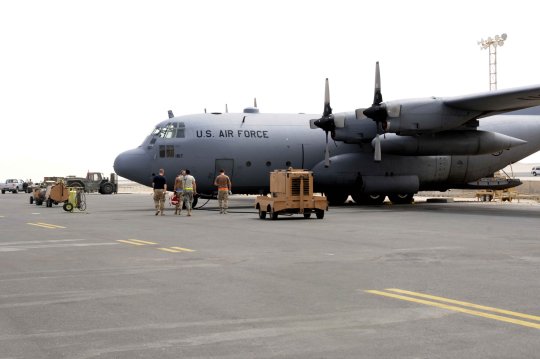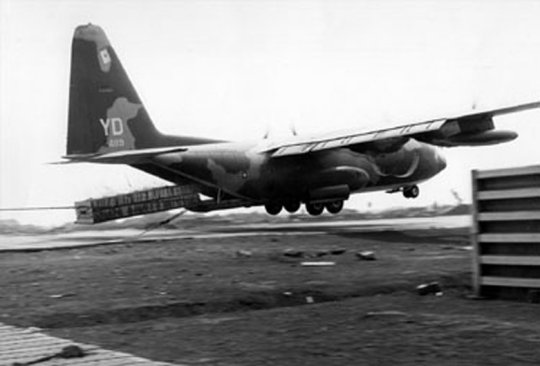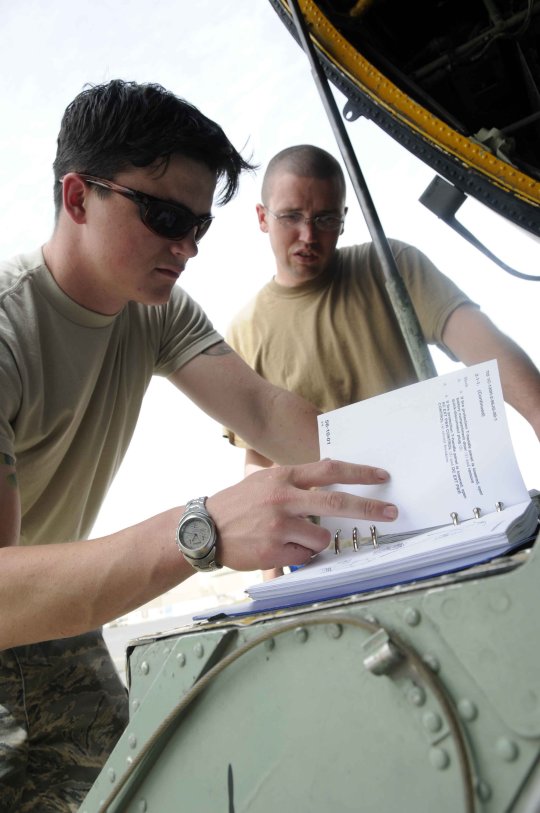« Happy Passover To The IDF and Theodore's World Jewish Friends | Main | Global Warming Cult vs the U.S. Marines »
April 19, 2008
"Patches" a C-130E Has Been Added To 746th Expeditionary Airlift Squadron



C-130 Unit Gets a New Bird With an Old History
By Senior Airman Tong Duong
379th Air Expeditionary Wing Public Affairs
U.S. Air Force, coalition and sister service forces have relied for years on the steady stream of supplies and equipment flown in by crewmembers of KC-135 Stratotankers, C-130 Hercules, C-17 Globemaster IIIs and other airlift workhorses.
One aircraft new to Southwest Asia carries something more - a rich history dating back more than 40 years.
The 746th Expeditionary Airlift Squadron recently added "Patches" a C-130E, Tail No. 62-1817 into its fleet, from Pope Air Force Base, N.C.
"She's a great lady," said Lt. Col. Daniel Tulley, 746th EAS commander, from Little Rock Air Force Base, Ark. "I've seen a picture of her at Air Mobility Command headquarters at Scott Air Force Base, Ill., and it was interesting to read about her crew's contribution to history. I'm proud to have her on our ramp."
According to Alan Marsh, 379th Air Expeditionary Wing historian, the People's Army of Vietnam launched what became a 77-day battle at Khe Sanh on Jan. 21, 1968. During this time, overland supply routes to U.S. troops at Khe Sanh were cut off and attempts to land aircraft were threatened by artillery fire from the North Vietnamese. Most supply efforts during this period were attempted by airdrops.On Feb. 5, Tail No. 62-1817 and her crew flew into the storm of enemy fire to deliver much needed supplies to the Marines besieged at the outpost. Lt. Col. Howard Dallman and his 345th Tactical Airlift Squadron crew loaded ammunition and a medical evacuation team at Da Nang and headed for Khe Sanh. Confronted with overcast weather and no communications with Khe Sanh, Colonel Dallman landed the C-130 under heavy enemy fire.
One shell hit the aircraft and ignited a fire, threatening the cargo boxes of ammo loaded in the plane. The crew stayed with the C-130 as it taxied down the runway and took additional hits by enemy fire, blowing out a tire. One engine quit when a mortar round exploded and threw dirt into it.
After the fire was extinguished, the valuable cargo was unloaded and the tire repaired, the C-130 crew took off, again sustaining hits from the enemy. Colonel Dallman received the Air Force Cross for his efforts to re-supply the Marines at Khe Sanh and all crew members received the Silver Star.
Decades later, Tail No. 62-1817 is still bringing the fight to the enemy, this time in the Middle East.
"It gives our crewmembers and maintainers a sense of pride to know that one of their aircraft has been through something that significant," Colonel Tulley said. "It reflects on the entire Air Force fleet, and is a testimony to the maintainers and crew members who fly them that these planes are still around and parked next to the newer C-130Js, doing the same missions."
Tech. Sgt. Jeremy Seay, 746th Aircraft Maintenance Unit crew chief, has worked on "Patches" more than once, and said her history is what he finds most interesting about her.
"This is my third time deploying with her," he said. "It's great to be able to work on a 45-year-old aircraft with so much history."
He said it's especially meaningful because his father served in Vietnam.
At his home station, Pope Air Force Base, N.C., Sergeant Seay enjoys maintaining all C-130 aircraft, but prefers to work on the older planes.
"I would rather work on E models (built in the early '60s) than the newer C-130Js (built in early 2000) because of their history and the significance of what they've done for our country," he said. "I've worked on many different variations of C-130s, from older Vietnam-era planes to ones that have seen recent campaigns such as the AC-130 gunships they have at Hurlbert Field, Fla., but I've got to say, 'Patches' is probably the most interesting of them all."
Since its activation in February, the 746th EAS has accomplished several combat airdrops, leaflet drops, and combat re-supply missions using its E, H and J model C-130 aircraft, Colonel Tulley said.
With the addition of another airframe, the 746th EAS can continue to impact the mission here and make history for future generations.
"Mobility Airmen and the planes we fly often make the greatest impact with sustained performance over time," Colonel Tulley said. "It's when you look back at the results after a period of time you realize the profound impact. For example, every one of our 19,000 passengers airlifted has been spared the danger of traveling via ground convoy, you can't measure the lives and injuries saved through the consistent, reliable airlift mobility assets provide."
Posted by Wild Thing at April 19, 2008 03:50 AM
Comments
Gotta love the HERCULESE! The AC-130 Herculese spectre gunships are devestating too!!
Posted by: darthcrUSAderworldtour07 at April 19, 2008 05:16 AM
There were a lot of aircraft nicknamed "Patches" in Vietnam. Some of the busiest people in Vietnam were sheet metal guys patching up all the ground fire hits in aircraft from helicopters to C-130s. Glad to see how many Vietnam veteran aircraft are still flying.
Posted by: TomR at April 19, 2008 05:46 AM
Darth, yes they helepd so much, really awesome.
Posted by: Wild Thing at April 19, 2008 11:49 AM
Tom, yes isn't it neat. I love how so many things from the Vietnam War are very much a part of helping our troops today.
Posted by: Wild Thing at April 19, 2008 11:50 AM
I just love that bird, many Lockheed Hercules found there way into civilian service after Vietnam. Back when Alaska discovered oil on it's North Slope the oil companies had no road access, it was all by air or sea. Back then supplies were brought in on sealifts during the July - August 3 week maximum break in the Arctic Ice from around Pt Barrow to the Prudhoe Bay oil fields, personnel transportation was from Fairbanks to Prudhoe via bush plane, landing on lakes either thawn or frozen. After oil was discovered the need for supplies increased, Deadhorse sprung up, providing a dirt strip to land on, at that time Atlantic Richfield had a dirt strip and was getting supplies via Hercules and the DeHavilland Twin Otter aircraft, the state regulated and controlled the Deadhorse strip, those Hercs made many a landing and take off from the ARCO strip until the Haul Road was punched through in '74, even then it was mostly air delivery until late '76. A lot of those Hercs came from Vietnam service and a few from the infamous Air America, there were 'patches on them', mostly flown by Alaska International Air, formerly Interior Airways, Inc., a company rumored to have had Air America connections which in turn became MarkAir, Inc.
Those Hercs hauled drill pipe, portable generators, parts and food, refined fuel, even broken down drilling rigs to the field to be reassembled. Some even hauled passengrs, we oil field workers to and from the patch and the real world, until modified 737's were brought into the patch. The Hercs were the lifeline. That Herc in Vietnam and in Alaska was one of the most reliable and safe aircraft I have ever flown on in both locales. It warms the old heart to see them still being lovingly maintained and still serving their missions. Thank you Chrissie.
Posted by: Jack at April 19, 2008 03:44 PM
Jack wow that is so interesting, thank you so much for sharing about that. VERY interesting!!
Posted by: Wild Thing at April 19, 2008 03:46 PM
